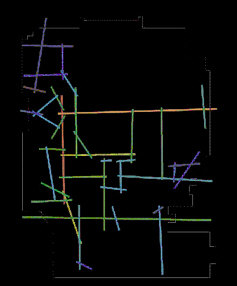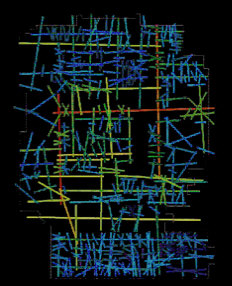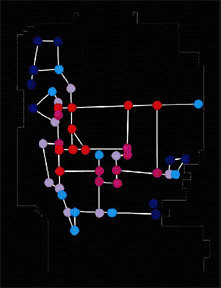


| Movement in Designed Environments | |
| Researcher | Saif Haq, PhD |
| Student Assistants | Sara Girotto Adetania Pramanik |



The issue of human movement has been of interest not only to researchers from various disciplines, but also to professionals who design and manage environments. The term ‘movement’ refers to those of human walkers as they navigate, distribute, way-find or browse. Operating from an architectural point of view this research puts emphasis on the environment; the identification and description of those environmental units that can be considered important in the way humans understand and operate in larger environmental 'wholes' and mechanisms of such movement. The study of movement therefore brings various research areas and professional interests such as Space Syntax, Wayfinding, Environmental Cognition, Facilities Management and Design into a collaborative framework.
Movement as a way of environment learning brings attention to relational properties of environmental units, as opposed to discrete ones. Relational properties, by definition, are derived from the configuration of spaces and are considered to become apparent to the moving observer. Traditionally, it had been difficult to describe and quantify relational variables, but with improved computing power and new theories, it is becoming easier. The theory and methods of Space Syntax is an example of such efforts and is a predominant research agenda. One area is the applicability of Space Syntax tools and methods to the study of deliberate movement.
Environmental Cognition deals with two sets of complex variables: the person and the environment. An important task in this endeavor is to ‘control’ these as far as possible. Typically, experiments were carried out either in real life settings or in some representations of those. Unfortunately, real life settings inhibit the control of extraneous variables and representation techniques restrict the sense of ‘immersion’ into an environment and do not allow actual movement. Therefore, it is necessary to have a system that allows not only the production of various immerse-able virtual environments, but also one that accommodates movement (exploration, wayfinding, navigation etc) within them. Production, management and use of such environments are also an important part of the research agenda.
Publications
Investigating the Syntax Line: Configurational Properties and Cognitive Correlates, in Environment and Planning B: Planning and Design 2003, volume 30(6) November, pages 841-863, Pion Publications, London, 2003
Ability and Intelligibility: Wayfinding and Environmental Cognition in the Designed Environment, (with Girotto) in Julienne Hanson Ed., Proceedings of Space Syntax 4th International Symposium, Space Syntax Laboratory, The Bartlett School of Graduate Studies, University College London, London, June 2003, pp. 68.1-68.20
Just down the road a piece: the development of topological knowledge of building layouts, (with Zimring), in Environment and Behavior, Vol 35, No.1, Jan 2003, pp. 132-160
Previously published in Peponis, J, Wineman, J. and Bafna S., Ed. Proceedings Space Syntax: 3rd International Symposium, A. Alfred Taubman College of Architecture and Urban Planning, University of Michigan, 2001, pp. 48.1-48.17
Expectation of Exploration: Evaluating the Effect of Environmental Variables on Wayfinding in Mann, T., Ed. The Power of Imagination, Orlando, Florida. 1999, pp. 84-94
Can Space Syntax predict Environmental Cognition, in Holanda, F, Ed. Space Syntax 2nd International Conference, Fundacao de Apoio a Pesquisa do Distrito Federal - FAP/DF, Brasilia, Brazil, 1999. pp. 44.1-44.14
Work in Progress
Use of Virtual Immersive Environments with User Controlled Movement (VIEUCoM) in Wayfinding and Environmental Cognition Research with Special emphasis on Space Syntax variables (with Prof. Glenn Hill and others)
Wayfinding and Environmental Cognition in large hospital complexes.
Pedestrian distribution as a criteria for evaluating campus layouts: the case of TexasTech University.
The role of Space Syntax in the study of wayfinding
Examination of microgenetic spatial development.